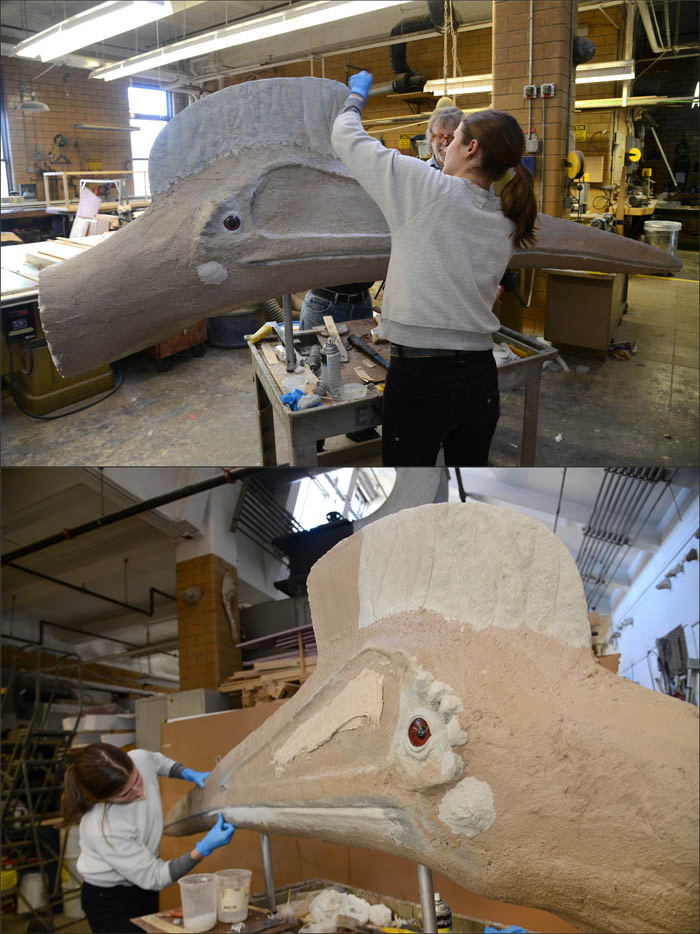How Pterosaurs Ruled the Skies Above the Dinosaurs

NEW YORK — Before birds really took off, the skies of prehistoric Earth belonged to the pterosaurs. These winged reptiles soared around the planet during the time of their relatives, the dinosaurs.
Pterosaurs first appear in the fossil record about 220 million years ago, making them the first vertebrates, or animals with backbones, to evolve the ability to fly on their own power. These creatures also rank as the largest flying animals, ever. Fossils suggest the biggest pterosaur, Quetzalcoatlus northropi, had a wingspan stretching about 33 feet (10 meters), longer than that of a small airplane. Of course, not all were giants. Of the more than 150 known species, some attained birdlike sizes, along the lines of sparrows or seagulls.
With size comes weight. Michael Habib, who studies biomechanics at the University of Southern California, has calculated that one particular group of pterosaurs may have weighed more than 661 pounds (300 kilograms), a weight they managed to consistently foist into the air and keep aloft.
"Flapping flight is one of the more challenging things you can do," Habib said during a panel discussion for a preview of a new pterosaur exhibition here at the American Museum of Natural History. In addition to displaying real pterosaur fossils, including one German specimen known as the Dark Wing, the exhibition includes a motion-sensor-based demonstration where visitors can virtually "pilot" two species of pterosaurs. [See Images of Pterosaurs & Flying Reptile Exhibit]
Evolving flight
Insects were the first organisms to take to the air using their own power. Among vertebrates, or animals with a backbone, pterosaurs, birds and bats each independently evolved the ability to fly by flapping wings derived from forelimbs. Each of these animals devised different means to accomplish the same lofty feat.
"One of the advantages of the pterosaur body plan in terms of flying animals is you can get bigger," Habib told Live Science. So, not surprisingly, pterosaurs massively outgrew bats and birds. (Among living birds, the wandering albatross has the largest wingspan, measuring up to about 11 feet, or 3.4 m.)
Get the world’s most fascinating discoveries delivered straight to your inbox.
Three anatomical requirements set the stage for large size in flying animals: wing anatomy that generates a large amount of lift per unit speed, hollow bones with a high ratio of stiffness to weight, and the muscle power to launch into the air, Habib said.
"Bats have the right launch system, but they don't have pneumatic [air-filled] bones. Birds have pneumatized bones, but they don't have the right launch system, and they don't have as high a lift coefficient [for their] wings," Habib said. "Pterosaurs are the only ones by happenstance that ended up with those three things."
The flying reptiles could also walk on all fours, and they most likely leaped into the air for takeoff, Habib said.
An exhibition panel at the museum demonstrates how bats, birds and pterosaurs created wings from the same bones humans have in their arms, hands and fingers. But among pterosaurs, a considerable portion of the wingspan comes from a long fourth finger, which corresponds to the human ring finger.
Birds took to the skies during pterosaurs' reign, but they were a little behind the reptiles, said exhibition curator Mark Norell, chair of the museum's paleontology department. Bats, which are mammals, evolved more recently; the earliest known fossil of an insect-eating bat dates back about 50 million years.
Exhibit giants
One of the exhibit's star items provides a rare glimpse of ancient skin. A fossil found in a 150-million-year-old German rock formation contained the preserved tissue of a pterosaur wing, which allowed scientists to detect layers of skin, blood vessels, muscles and the long fibers forming a series of supports within the wing. The color of the wing membrane led researchers to dub the fossil Dark Wing, which has never before been exhibited outside of Germany.
The same formation has yielded about 11 species of Archaeopteryx, a winged animal viewed as a transitional form between predatory dinosaurs and modern birds, Norell said.
The exhibition "Pterosaurs: Flight in the Age of Dinosaurs," explores other discoveries, including the first known pterosaur egg and tracks that show these animals walked on all fours. The exhibit explains that traces of fibers found on fossils from the pterosaur Sordes pilosus, or hairy devil, suggest these animals had fuzzy coats and were likely warm blooded.
The exhibition opens on Saturday, April 5, and runs until Jan. 4. It was co-curated by Alexander Kellner, a museum research associate and paleontologist at the Museu Nacional in Rio de Janeiro.
Follow Live Science @livescience, Facebook & Google+. Original article on Live Science.





